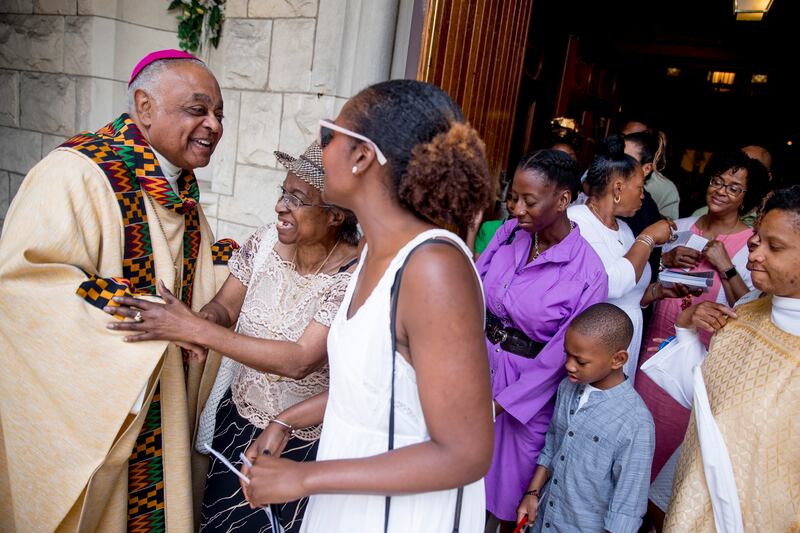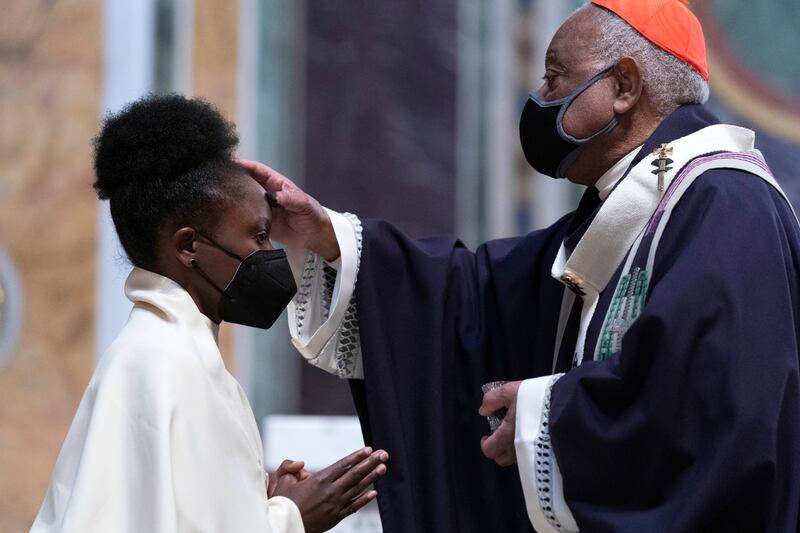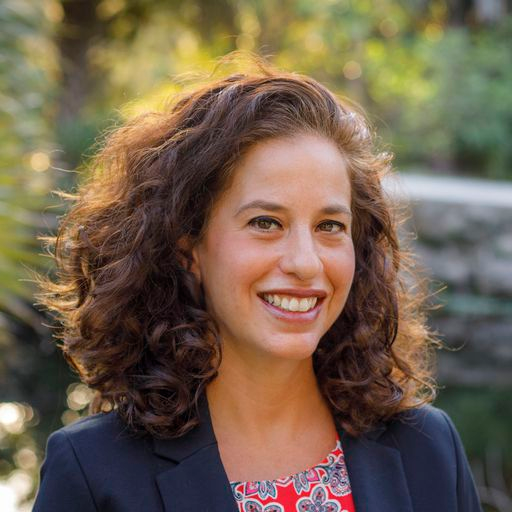Gloria Purvis was 12 when she went home from parochial school one afternoon and announced to her Baptist father and Methodist mother that she was converting to Catholicism. While sitting in the school’s chapel recently, she’d had a “mystical experience,” she told them, explaining that she’d felt her body engulfed in fire and flame but it didn’t hurt. At that moment, she knew that the eucharist “was alive and real,” said Purvis, who today hosts “The Gloria Purvis Podcast.”
In addition to that moment, Purvis credits her conversion to the fact that she had Black Catholic role models in the priest, Father Figaro, and in the school’s nuns. In religion class, when Purvis told one of those nuns “I think I’m Catholic,” the woman responded, “No, you gotta ask your parents.”
Purvis didn’t ask her parents if she could convert to Catholicism so much as she told them. Her Methodist mother responded, “‘OK, if you’re gonna be Catholic, you’re going to Mass every Sunday, on every holy day, there’s no meat on Fridays and you’re gonna pray the rosary.” At an age when other girls were being dropped off at the mall, Purvis’ parents started dropping her at Mass.
Purvis grew up in Charleston, South Carolina, a place sometimes called the Holy City because there are so many churches. On Sundays, when Purvis finished up with Mass, she would walk over to the Baptist church her grandmother attended and join her in the pew.
Though Purvis’ parents didn’t become Catholics, her conversion changed the household, Purvis said. When she gave up something for Lent, everyone did because her mom wasn’t cooking multiple meals.
Purvis’ two sisters followed in her footsteps, becoming Catholics, too. Her whole family had a relationship with Father Figaro — when Purvis’ parents purchased a new home, she and her sisters told them, “We can’t sleep in the house until it’s blessed,” Purvis recalled. And they all became intimately familiar with the faith after one of Purvis’ sisters died in a car accident at the age of 21.
Afterward, the family maintained ties with Father Figaro, hosting him and visiting priests when they were passing through town. “They would have dinner with a non-Catholic family,” said Purvis.
New data from Pew Research Center suggests that Purvis’ experience is, in many ways, typical of Black Catholics. Like Purvis, a sizable chunk — 16% — are converts to the faith. And also like Purvis, who takes an uncompromising position on social justice issues, a large majority of Black Catholics say that standing against racism (77%) and sexism (75%) are essential components of their faith.
Though Black Catholics make up a minority of Black Americans — most Black Americans are Protestants — there are around 3 million in the United States. While a majority (68%) are American-born, 12% hail from sub-Saharan Africa and 11% are from the Caribbean, Pew reported.
Black Catholics are a “relatively small group,” said Besheer Mohamed, a senior researcher at Pew Research Center and co-author of the new report. “But there are still millions of them. It’s not a group that you can say, ‘There aren’t that many you don’t need to study them.’”
Until now, Black Catholics have gone largely overlooked by researchers and underreported by the media, save for the attention garnered in 2019 when Pope Francis appointed a Black man, the Most Rev. Wilton Gregory, to be the archbishop of Washington, and then again in 2020 when the Most Rev. Gregory was named cardinal, becoming the first Black cardinal in American history.

Pew’s survey of Black Catholics is an attempt to shine light on this oft-overlooked segment of the population and to “unpack diversity among racial groups, in general, and Black Americans in particular,” said Mohamed.
Like Black Protestants, Black Catholics rank higher than whites on some key measures of religiosity, like praying daily, reading scriptures outside of church, saying that religion is very important to them and praying when making decisions.
While Black Catholics have much in common with their Black Protestant counterparts, they diverge on a few issues.
“The one interesting wrinkle is that Black Catholics are not significantly more likely than white or Hispanic Catholics to attend services more regularly,” said Mohamed. Black Protestants, on the whole, attend church more than their white counterparts.
Black Catholics are also less likely than Black Protestants to say that believing in God and abstaining from sex before marriage are important to their religious identity.
Additionally, most Black Protestants attend Black congregations while few Black Catholics report being part of majority Black congregations. And though they attend services alongside white and Hispanic Catholics, Black Catholics are also distinct from these two groups in that they are more likely to say that opposing racism and sexism are essential parts of their faith.
Black Catholics, along with Hispanic Catholics, are also different from White Catholics in regards to what they want from a church, with 40% of Black Catholics and 42% of Hispanic Catholics saying that “it is essential that churches teach practical job and life skills, and that they offer sermons that address political topics such as immigration and race relations. Only 18% of White Catholics said the same, Pew reported.
These expectations mirror those of Black Protestants, Mohamed noted.
For Purvis, both her personal experience and Pew’s new study underscore the importance of having Black Catholic clergy in schools. Pew’s report mentions that the number of Black Catholics grew during the Great Migration in the mid-20th century, when Black Americans left the South and ended up in cities with “large preexisting Catholic populations and, in many cases, strong parochial school systems.”
The Rev. Myra Brown’s experience embodies this history. Growing up in Rochester, New York, she went to all kinds of churches, worshiping with everyone from Pentecostals, Spiritualists and Catholics. Though her parents, who were originally from Arkansas, hailed from a Protestant background, they hadn’t affixed themselves to any particular denomination since moving north. Attending a variety of services taught the Rev. Brown “God was everywhere,” she said.
She landed in Catholicism as a teenager only because the choir was a few souls short. “I was actually carted off to the Catholic Church to sing,” the Rev. Brown joked. Once she was there, she said, “I just really fell in love with the community, the tradition, the people and Jesus.”
And then, about a decade later, came the call to ministry.
By that point, people had got to talking about the Rev. Brown. She was ministering on the streets on the weekend and the folks she prayed for had experienced what they felt were miracles. The white priest of St. Bridget’s, the Catholic church she attended, approached the Rev. Brown — who was just 23 or 24 at the time — and asked her to preach.
“I said no, right, because I was Black, Catholic and a woman. ... There was no model for that,” the Rev. Brown said.
The priest asked her to go home and pray about it. A mother of two young children, the Rev. Brown was living with a friend. In her attic bedroom, she got down on her knees and prayed about the priest’s request. But there was no response.
So she got up, went downstairs and started vacuuming. And then she felt someone pulling on her shirt, from the front, so hard that the fabric became taut, she said.
The Rev. Brown returned to that attic bedroom, got down on her knees again, and asked, “‘God, are you calling me?’”
“He said, ‘Yes, I’ve called you to preach and teach my word,’” she said as she recounted the moment. “I was just flabbergasted. I started arguing. I was like, ‘God, are you kidding me?’”
That was 30 years ago. After her first sermon, the Rev. Brown went on to join the ministry staff of Rochester’s Corpus Christi Church, which, at the time, was Roman Catholic. After seven years at Corpus Christi, she and some other clergy broke off from the Roman Catholic diocese “over inclusion” issues, she said.
They started an independent Catholic church called Spiritus Christi, which the Rev. Brown leads today. Though some Catholics might not acknowledge this leadership role, the Rev. Brown represents another face of Black Catholicism — one that points to the way Black Americans’ emphasis on racial and gender equity might broaden the tent of American Catholicism.


 alt=Mya Jaradat
alt=Mya Jaradat